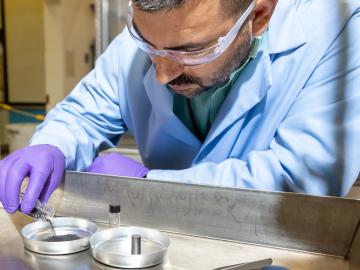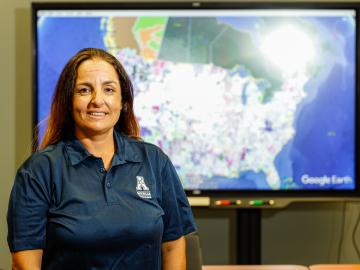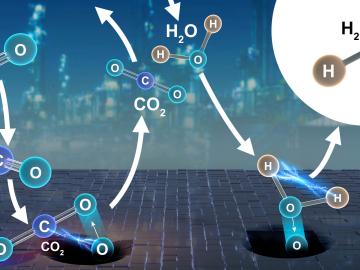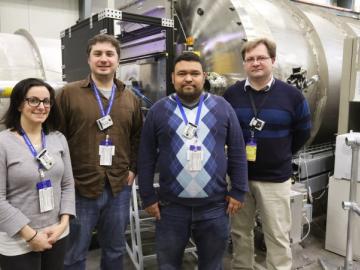
Filter News
Area of Research
- Advanced Manufacturing (2)
- Biology and Environment (15)
- Computer Science (1)
- Electricity and Smart Grid (1)
- Energy Science (34)
- Functional Materials for Energy (2)
- Fusion and Fission (4)
- Fusion Energy (4)
- Isotope Development and Production (1)
- Isotopes (3)
- Materials (36)
- Materials for Computing (2)
- National Security (11)
- Neutron Science (37)
- Nuclear Science and Technology (6)
- Quantum information Science (2)
- Supercomputing (15)
News Topics
- (-) Advanced Reactors (11)
- (-) Cybersecurity (12)
- (-) Energy Storage (33)
- (-) Grid (19)
- (-) Hydropower (8)
- (-) Isotopes (5)
- (-) Microscopy (18)
- (-) Neutron Science (35)
- (-) Space Exploration (10)
- 3-D Printing/Advanced Manufacturing (28)
- Artificial Intelligence (26)
- Big Data (16)
- Bioenergy (28)
- Biology (28)
- Biomedical (11)
- Biotechnology (4)
- Buildings (16)
- Chemical Sciences (15)
- Clean Water (10)
- Composites (5)
- Computer Science (55)
- Coronavirus (9)
- Critical Materials (5)
- Element Discovery (1)
- Environment (55)
- Exascale Computing (10)
- Fossil Energy (1)
- Frontier (12)
- Fusion (13)
- High-Performance Computing (16)
- Irradiation (1)
- ITER (2)
- Machine Learning (15)
- Materials (37)
- Materials Science (38)
- Mercury (2)
- Molten Salt (1)
- Nanotechnology (15)
- National Security (17)
- Nuclear Energy (30)
- Partnerships (8)
- Physics (16)
- Polymers (7)
- Quantum Computing (7)
- Quantum Science (19)
- Security (6)
- Simulation (6)
- Summit (16)
- Transportation (22)
Media Contacts

Ask Tyler Gerczak to find a negative in working at the Department of Energy’s Oak Ridge National Laboratory, and his only complaint is the summer weather. It is not as forgiving as the summers in Pulaski, Wisconsin, his hometown.

Isabelle Snyder calls faults as she sees them, whether it’s modeling operations for the nation’s power grid or officiating at the US Open Tennis Championships.

Using additive manufacturing, scientists experimenting with tungsten at Oak Ridge National Laboratory hope to unlock new potential of the high-performance heat-transferring material used to protect components from the plasma inside a fusion reactor. Fusion requires hydrogen isotopes to reach millions of degrees.

Using the Titan supercomputer at Oak Ridge National Laboratory, a team of astrophysicists created a set of galactic wind simulations of the highest resolution ever performed. The simulations will allow researchers to gather and interpret more accurate, detailed data that elucidates how galactic winds affect the formation and evolution of galaxies.

Collaborators at the Department of Energy’s Oak Ridge National Laboratory and U.S. universities used neutron scattering and other advanced characterization techniques to study how a prominent catalyst enables the “water-gas shift” reaction to purify and generate hydrogen at industrial scale.

Scientists at Oak Ridge National Laboratory studying quantum communications have discovered a more practical way to share secret messages among three parties, which could ultimately lead to better cybersecurity for the electric grid

A team of researchers at Oak Ridge National Laboratory have demonstrated that designed synthetic polymers can serve as a high-performance binding material for next-generation lithium-ion batteries.

Scientists from the National Institute of Standards and Technology (NIST) and the University of Maryland are using neutrons at Oak Ridge National Laboratory (ORNL) to capture new information about DNA and RNA molecules and enable more accurate computer simulations of how they interact with everything from proteins to viruses.

Researchers have pioneered a new technique using pressure to manipulate magnetism in thin film materials used to enhance performance in electronic devices.

For the first time, Oak Ridge National Laboratory has completed testing of nuclear fuels using MiniFuel, an irradiation vehicle that allows for rapid experimentation.


